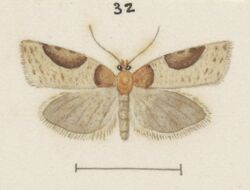Biology:Epichorista aspistana
| Epichorista aspistana | |
|---|---|

| |
| Illustration of male | |
| Scientific classification | |
| Domain: | Eukaryota |
| Kingdom: | Animalia |
| Phylum: | Arthropoda |
| Class: | Insecta |
| Order: | Lepidoptera |
| Family: | Tortricidae |
| Genus: | Epichorista |
| Species: | E. aspistana
|
| Binomial name | |
| Epichorista aspistana (Meyrick, 1882)[1]
| |
| Synonyms[2] | |
| |
Epichorista aspistana is a species of moth of the family Tortricidae.[2] It is endemic to New Zealand and has been collected in Canterbury and Otago. This species inhabits moist grassy areas at altitudes ranging from sea level to 1650m. Larvae feed on species within the genus Acaena. Adults are on the wing in November to February.
Taxonomy
This species was first described by Edward Meyrick in 1882 using specimens collected by J. D. Enys at Porters Pass and named Proselena aspistana.[3] Meyrick went on to give a fuller description of the species in 1883.[4] In 1911 Meyrick placed this species in the genus Epichorista.[5] George Hudson, in 1928, discussed and illustrated this species in his book The butterflies and moths of New Zealand.[6] In 1988 J. S. Dugdale confirmed this placement.[2] In 2010 this placement was again confirmed by Robert Hoare in the New Zealand Inventory of Biodiversity.[1] The male lectotype, collected at Castle Hill in Canterbury, is held at the Natural History Museum, London.[2]
Description
Meyrick described this species as follows:
Male. — 13 mm. Head, palpi, and thorax whitish-grey, somewhat mixed with fuscous (but damaged). Antennae whitish-grey (?). Abdomen whitish-grey. Legs whitish-grey, anterior and middle pair suffused with dark fuscous except at apex of joints. Forewings oblong, rather narrow, slightly dilated posteriorly, costa moderately arched near base, thence nearly straight, somewhat sinuate beyond middle, hindmargin rather strongly oblique, nearly straight, very slightly sinuate ; whitish-grey, with some scattered spots of dark fuscous scales; basal patch reddish-brown, exterior edge sharply marked, broadly dark fuscous, from 1⁄5 of costa to 1⁄5 of inner margin, irregular, hardly angulated ; a large reddish-brown triangular costal patch, extending on costa from 1⁄3 to near apex, reaching rather more than half across wing, apex broken and partially suffused, anterior and posterior edges sharply marked, broadly margined with dark fuscous, costal edge marked with three small dark fuscous spots ; a similar small dark fuscous spot on costa before apex : cilia grey- whitish, with a dark grey basal line. Hindwings grey, with a pencil of long whitish-yellowish hairs on costa at base ; cilia pale grey.[4]
Distribution
This species is endemic to New Zealand and has been found at the species type locality of Porters Pass as well as at near Dunedin.[1][6]
Habitat
This species inhabits moist grassy areas and has been collected at altitudes ranging from sea level to 1650m.[6][7][8]
Host species
Larvae of this species have been collected on plants in the genus Acaena.[9][8]
Behaviour
The larvae of this species web the leaves of its host plants together and feed from this shelter.[10] The adults of this species are on the wing from November to February.[7][11]
References
- ↑ 1.0 1.1 1.2 , pp. 464, Wikidata Q45922947
- ↑ 2.0 2.1 2.2 2.3 , pp. 122, Wikidata Q45083134
- ↑ , pp. 277, Wikidata Q111013849
- ↑ 4.0 4.1 , pp. 42, Wikidata Q111013914
- ↑ , pp. 83, Wikidata Q111014011
- ↑ 6.0 6.1 6.2 , pp. 237-238, Wikidata Q58593286
- ↑ 7.0 7.1 "Epichorista aspistana". 2022. https://www.aucklandmuseum.com/collections-research/collections/record/am_naturalsciences-object-176918.
- ↑ 8.0 8.1 , pp. 269, Wikidata Q60326057
- ↑ , pp. 15, Wikidata Q110318301
- ↑ "Epichorista aspistana (Meyrick, 1882)". 2022. https://plant-synz.landcareresearch.co.nz/ReportForm.aspx?RecordId=4642&Type=H&ReportType=Adv&SortBy=Alpha&Biostatus=a,c,e,n.
- ↑ Crown Pastoral Land Tenure Review Coronet Peak Conservation Resources Report - Part 2 (Report). Land Information New Zealand. 2006. p. APPENDIX 6: Invertebrate Species List. https://www.linz.govt.nz/system/files_force/media/crown-property-attachments/tenure-review/ig/coronet-peak-crr-pt2.pdf?download=1. Retrieved 25 February 2022.
Wikidata ☰ Q13609301 entry


